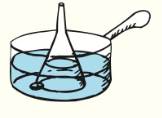
Conceptual Physics (12th Edition)
12th Edition
ISBN: 9780321909107
Author: Paul G. Hewitt
Publisher: PEARSON
expand_more
expand_more
format_list_bulleted
Concept explainers
Textbook Question
Chapter 17, Problem 31RCQ
Place a Pyrex funnel mouth-down in a saucepan full of water so that the narrow tube of the funnel protrudes above water. Rest a part if the funnel on a nail or a coin so that water can get under it. Place the pan on a strove and watch the water as it begins to boil. Where do the bubbles form first? Why? As the bubbles rise, they expand rapidly and push water ahead of them. The funnel confines the water, which is forced up the tube and driven out at the top. Now do you know how a geyser and a coffee percolator work?

Expert Solution & Answer
Want to see the full answer?
Check out a sample textbook solution
Students have asked these similar questions
Checkpoint 4
The figure shows four orientations of an electric di-
pole in an external electric field. Rank the orienta-
tions according to (a) the magnitude of the torque
on the dipole and (b) the potential energy of the di-
pole, greatest first.
(1)
(2)
E
(4)
What is integrated science.
What is fractional distillation
What is simple distillation
19:39 ·
C
Chegg
1 69%
✓
The compound beam is fixed at Ę and supported by rollers at A and B. There are pins at C and D. Take
F=1700 lb. (Figure 1)
Figure
800 lb
||-5-
F
600 lb
بتا
D
E
C
BO
10 ft 5 ft 4 ft-—— 6 ft — 5 ft-
Solved Part A The compound
beam is fixed at E and...
Hình ảnh có thể có bản quyền. Tìm hiểu thêm
Problem
A-12
% Chia sẻ
kip
800 lb
Truy cập )
D Lưu
of
C
600 lb
|-sa+ 10ft 5ft 4ft6ft
D
E
5 ft-
Trying
Cheaa
Những kết quả này có
hữu ích không?
There are pins at C and D To F-1200 Egue!)
Chegg
Solved The compound b...
Có Không ☑
|||
Chegg
10
וח
Chapter 17 Solutions
Conceptual Physics (12th Edition)
Ch. 17 - Prob. 1RCQCh. 17 - Do the molecules in a liquid all have about the...Ch. 17 - What is evaporation?Ch. 17 - What is evaporation a cooling process?Ch. 17 - What is sublimation?Ch. 17 - Prob. 6RCQCh. 17 - Why is a steam burn more damaging than a burn from...Ch. 17 - Why do you feel uncomfortably warm on a hot and...Ch. 17 - Distinguish between humid and relative humidity.Ch. 17 - Why does water vapor in the air condense when the...
Ch. 17 - Why does warm, moist air from clouds when it...Ch. 17 - What is the basic difference between a cloud and...Ch. 17 - Distinguish between evaporation and boiling.Ch. 17 - Does increased atmospheric pressure increase or...Ch. 17 - Is it the boiling of water or the higher...Ch. 17 - Why doesn’t the water at the bottom of geyser boil...Ch. 17 - What happens to the water pressure at the bottom...Ch. 17 - Why doesn’t energy added to boiling water increase...Ch. 17 - When will water boil at a temperature lower...Ch. 17 - Prob. 20RCQCh. 17 - Why does increasing the temperature of a solid...Ch. 17 - Why does decreasing the temperature of a liquid...Ch. 17 - Why doesn’t water freeze at 00C when foreign ions...Ch. 17 - What happens to the hexagonal open structure of...Ch. 17 - Why doesn’t wire simply cut a block of ice in two...Ch. 17 - Does a liquid release energy or absorb energy when...Ch. 17 - Prob. 27RCQCh. 17 - Does the heat that is discharge at the...Ch. 17 - How many calories are needed to change the...Ch. 17 - Cite two reasons why firewalkers don’t burn their...Ch. 17 - Place a Pyrex funnel mouth-down in a saucepan full...Ch. 17 - Prob. 32RCQCh. 17 - Prob. 33RCQCh. 17 - Prob. 34RCQCh. 17 - Prob. 35RCQCh. 17 - Prob. 36RCQCh. 17 - The quantity of heat with temperature change is...Ch. 17 - Prob. 38RCQCh. 17 - Prob. 39RCQCh. 17 - Consider 50g of hot water at 800C poured into a...Ch. 17 - 50g chunk of 800C iron is dropped into a cavity in...Ch. 17 - Prob. 42RCQCh. 17 - Prob. 43RCQCh. 17 - 44. The heat of vaporization of ethyl alcohol is...Ch. 17 - Rank the boiling water temperatures from highest...Ch. 17 - From greatest to least, rank the energies needed...Ch. 17 - When you step out of a swimming pool on a hot, dry...Ch. 17 - Why is sweating an efficient mechanism for cooling...Ch. 17 - Why does blowing over hot soup cool the soup?Ch. 17 - What happens to the temperature of a pan of water...Ch. 17 - What is the source of energy that keeps the...Ch. 17 - An inventor claims to have developed a new perfume...Ch. 17 - Does a common electric fan cool the air in a room?...Ch. 17 - Prob. 54RCQCh. 17 - Prob. 55RCQCh. 17 - Prob. 56RCQCh. 17 - 57. Why are icebergs often surrounded by fog?
Ch. 17 - Prob. 58RCQCh. 17 - Prob. 59RCQCh. 17 - Prob. 60RCQCh. 17 - Prob. 61RCQCh. 17 - Prob. 62RCQCh. 17 - 63. A great amount of water vapor changes phase to...Ch. 17 - 64. Why does the temperature of boiling water...Ch. 17 - Prob. 65RCQCh. 17 - Prob. 66RCQCh. 17 - Prob. 67RCQCh. 17 - Prob. 68RCQCh. 17 - 69. Water will boil spontaneously in a vacuum—on...Ch. 17 - Prob. 70RCQCh. 17 - Prob. 71RCQCh. 17 - Prob. 72RCQCh. 17 - 73. If water that boils due to reduced pressure in...Ch. 17 - Prob. 74RCQCh. 17 - Prob. 75RCQCh. 17 - Prob. 76RCQCh. 17 - Prob. 77RCQCh. 17 - Prob. 78RCQCh. 17 - Prob. 79RCQCh. 17 - Prob. 80RCQCh. 17 - Prob. 81RCQCh. 17 - Prob. 82RCQCh. 17 - Prob. 83RCQCh. 17 - Prob. 84RCQCh. 17 - Prob. 85RCQCh. 17 - Prob. 86RCQCh. 17 - Prob. 87RCQCh. 17 - Prob. 88RCQCh. 17 - Prob. 89RCQCh. 17 - Prob. 90RCQCh. 17 - 91.Why is half-frozen fruit punch always sweeter...Ch. 17 - Prob. 92RCQCh. 17 - Prob. 93RCQCh. 17 - Prob. 94RCQCh. 17 - Prob. 95RCQCh. 17 - Prob. 96RCQCh. 17 - Prob. 97RCQCh. 17 - Prob. 98RCQCh. 17 - Prob. 99RCQCh. 17 - Prob. 100RCQCh. 17 - Prob. 101RCQCh. 17 - Prob. 102RCQCh. 17 - Prob. 103RCQCh. 17 - Prob. 104RCQCh. 17 - 105. When can you add heat to something without...Ch. 17 - Prob. 106RCQCh. 17 - 107. When can you withdraw heat from something...Ch. 17 - Discuss why water can issue from deep underwater...Ch. 17 - Prob. 109RCQCh. 17 - Prob. 110RCQ
Knowledge Booster
Learn more about
Need a deep-dive on the concept behind this application? Look no further. Learn more about this topic, physics and related others by exploring similar questions and additional content below.Similar questions
- air is pushed steadily though a forced air pipe at a steady speed of 4.0 m/s. the pipe measures 56 cm by 22 cm. how fast will air move though a narrower portion of the pipe that is also rectangular and measures 32 cm by 22 cmarrow_forwardNo chatgpt pls will upvotearrow_forward13.87 ... Interplanetary Navigation. The most efficient way to send a spacecraft from the earth to another planet is by using a Hohmann transfer orbit (Fig. P13.87). If the orbits of the departure and destination planets are circular, the Hohmann transfer orbit is an elliptical orbit whose perihelion and aphelion are tangent to the orbits of the two planets. The rockets are fired briefly at the depar- ture planet to put the spacecraft into the transfer orbit; the spacecraft then coasts until it reaches the destination planet. The rockets are then fired again to put the spacecraft into the same orbit about the sun as the destination planet. (a) For a flight from earth to Mars, in what direction must the rockets be fired at the earth and at Mars: in the direction of motion, or opposite the direction of motion? What about for a flight from Mars to the earth? (b) How long does a one- way trip from the the earth to Mars take, between the firings of the rockets? (c) To reach Mars from the…arrow_forward
- No chatgpt pls will upvotearrow_forwarda cubic foot of argon at 20 degrees celsius is isentropically compressed from 1 atm to 425 KPa. What is the new temperature and density?arrow_forwardCalculate the variance of the calculated accelerations. The free fall height was 1753 mm. The measured release and catch times were: 222.22 800.00 61.11 641.67 0.00 588.89 11.11 588.89 8.33 588.89 11.11 588.89 5.56 586.11 2.78 583.33 Give in the answer window the calculated repeated experiment variance in m/s2.arrow_forward
arrow_back_ios
SEE MORE QUESTIONS
arrow_forward_ios
Recommended textbooks for you
 College PhysicsPhysicsISBN:9781305952300Author:Raymond A. Serway, Chris VuillePublisher:Cengage Learning
College PhysicsPhysicsISBN:9781305952300Author:Raymond A. Serway, Chris VuillePublisher:Cengage Learning Principles of Physics: A Calculus-Based TextPhysicsISBN:9781133104261Author:Raymond A. Serway, John W. JewettPublisher:Cengage Learning
Principles of Physics: A Calculus-Based TextPhysicsISBN:9781133104261Author:Raymond A. Serway, John W. JewettPublisher:Cengage Learning Glencoe Physics: Principles and Problems, Student...PhysicsISBN:9780078807213Author:Paul W. ZitzewitzPublisher:Glencoe/McGraw-Hill
Glencoe Physics: Principles and Problems, Student...PhysicsISBN:9780078807213Author:Paul W. ZitzewitzPublisher:Glencoe/McGraw-Hill Physics for Scientists and Engineers, Technology ...PhysicsISBN:9781305116399Author:Raymond A. Serway, John W. JewettPublisher:Cengage Learning
Physics for Scientists and Engineers, Technology ...PhysicsISBN:9781305116399Author:Raymond A. Serway, John W. JewettPublisher:Cengage Learning College PhysicsPhysicsISBN:9781938168000Author:Paul Peter Urone, Roger HinrichsPublisher:OpenStax College
College PhysicsPhysicsISBN:9781938168000Author:Paul Peter Urone, Roger HinrichsPublisher:OpenStax College Physics for Scientists and Engineers with Modern ...PhysicsISBN:9781337553292Author:Raymond A. Serway, John W. JewettPublisher:Cengage Learning
Physics for Scientists and Engineers with Modern ...PhysicsISBN:9781337553292Author:Raymond A. Serway, John W. JewettPublisher:Cengage Learning

College Physics
Physics
ISBN:9781305952300
Author:Raymond A. Serway, Chris Vuille
Publisher:Cengage Learning

Principles of Physics: A Calculus-Based Text
Physics
ISBN:9781133104261
Author:Raymond A. Serway, John W. Jewett
Publisher:Cengage Learning

Glencoe Physics: Principles and Problems, Student...
Physics
ISBN:9780078807213
Author:Paul W. Zitzewitz
Publisher:Glencoe/McGraw-Hill

Physics for Scientists and Engineers, Technology ...
Physics
ISBN:9781305116399
Author:Raymond A. Serway, John W. Jewett
Publisher:Cengage Learning

College Physics
Physics
ISBN:9781938168000
Author:Paul Peter Urone, Roger Hinrichs
Publisher:OpenStax College

Physics for Scientists and Engineers with Modern ...
Physics
ISBN:9781337553292
Author:Raymond A. Serway, John W. Jewett
Publisher:Cengage Learning
A Level Physics – Ideal Gas Equation; Author: Atomi;https://www.youtube.com/watch?v=k0EFrmah7h0;License: Standard YouTube License, CC-BY